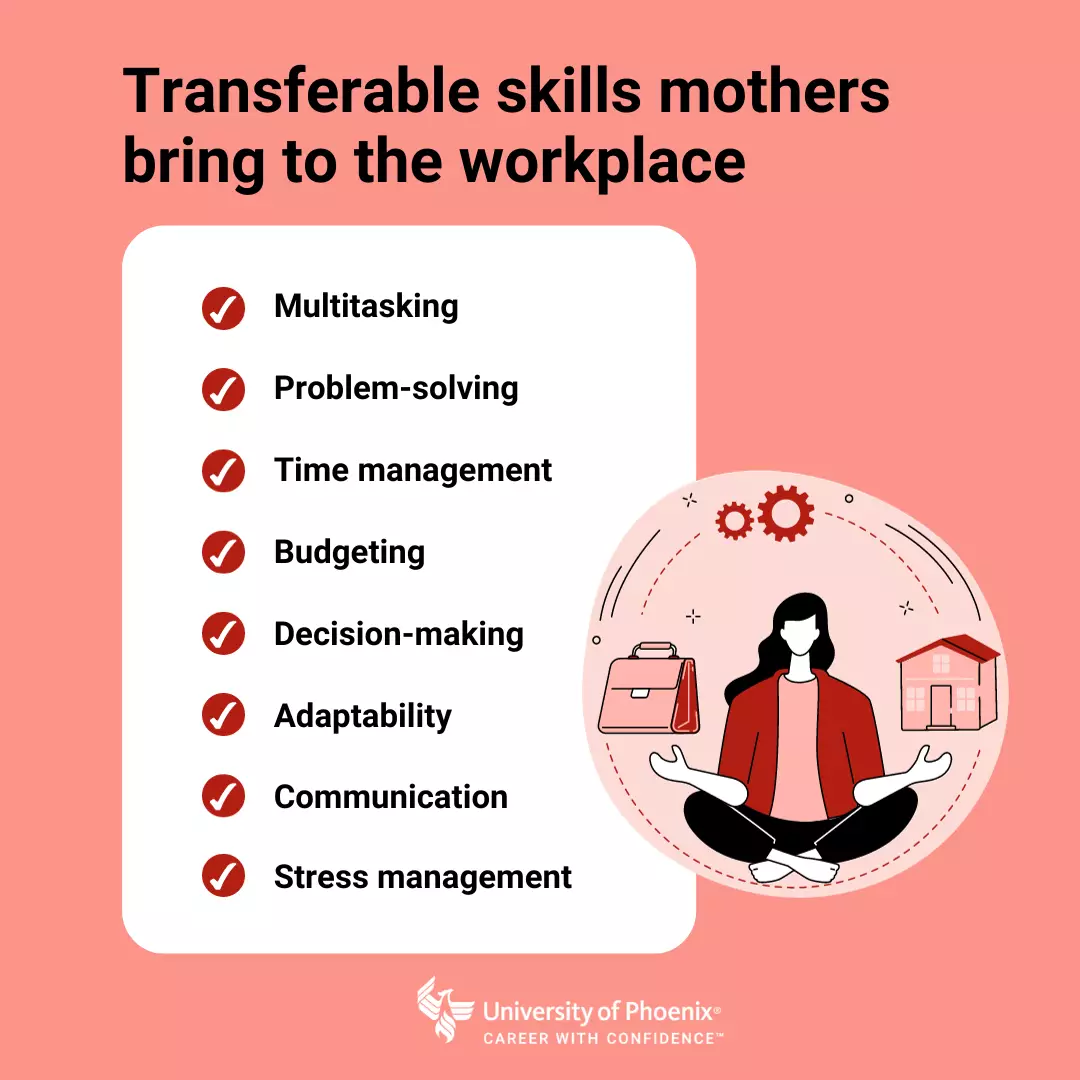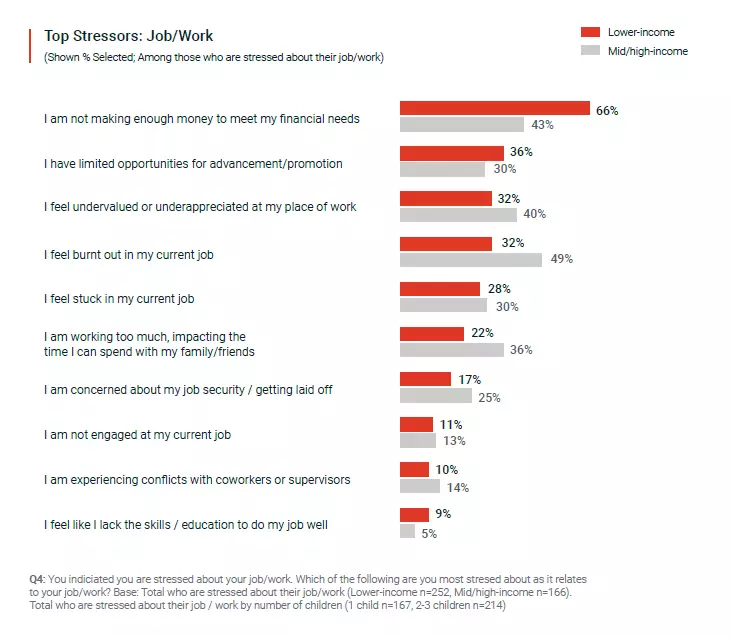Working-mom burnout: The high cost of having it all

Written by Elizabeth Exline

Reviewed by Jessica Roper, MBA, director of Career Services at University of Phoenix

2020 was not kind to Blair Westblom, chief financial officer at University of Phoenix. She was raising her two teenage daughters as a single mom after finalizing her divorce a year earlier. Then, suddenly, her parents passed away within weeks of each other.
The loss was tremendous, but Westblom powered on. She went to work, parented her children and began to attend to her parents’ estate. By external standards, she was successful. She always had been, whether she was breaking barriers in school (she attended a formerly all-male high school in California), working in investment banking or climbing the ladder at UOPX, where she’d moved from having one direct report to becoming CFO in the space of 10 years.
By internal standards, however, Westblom had hit her limit. Recognizing she wasn’t processing her grief, she requested six weeks of leave so she could attend to her family and herself.
“As mothers and as women, we’re so accustomed to prioritizing everyone else’s needs,” she observes. “But I think I came to a point where I realized if I don’t take care of me, then no one else is going to care for my children.”
Taking time off wasn’t easy for Westblom, who struggled with questions of whether the request would hurt her career. But she’d also worked hard to develop self-awareness and a set of values she could not ignore.
“It’s almost like a frog in boiling water,” she explains. “You have to check in with yourself and recognize, ‘This is not OK. I’m not on a good path.’”
From there, you have to do something about it. “It was truly one of those things where I was like, ‘What are my values?’” Westblom says. “Career is not actually number one. My family is number one. And that doesn’t mean I’m not prioritizing my career. It just means … [asking myself] ‘What am I going to be thankful for doing — or regret not doing — a year from now?’”
Who’s feeling the burn?
Westblom’s circumstances were extraordinary, but her experience with burnout was not. According to the Mothers Overcome More™ (M.O.M.) report by UOPX and Motherly, 49% of mid- to high-income* working mothers experience burnout at work.
Why? Jill Koziol, co-founder and CEO of Motherly, and Jessica Roper, the director of career services at UOPX, have a few theories, starting with the myth that you can and should “want it all.” Career, family, self-care — each of these goals comes with a time commitment. The more you take on, the more the pressure grows.
“Higher-income roles [also] often come with greater responsibilities, longer hours, more take-home work and higher stakes, contributing to stress and exhaustion,” Koziol adds.
Granted, the compensation justifies some of these demands. But even the financial advantages aren’t always enough: The M.O.M. report found that a full 30% of mid- to high-income working mothers said their income didn’t cover their basic needs.
“Societal expectations and stereotypes about ‘middle to high income’ can lead to a lack of empathy or support for these mothers,” Koziol notes.
"There’s an assumption that financial struggle is less valid or severe for this demographic, which isolates them further and minimizes their experiences."
Why working-mom burnout matters
Aside from the ethical concerns pertaining to nearly half of mid- to high-income working mothers feeling spread too thin, there are practical reasons to justify remediation. According to Koziol, well-supported working moms bring significant value to their organizations, including:
- Enhanced leadership and decision-making: “Their unique experiences with work and family life can enhance their leadership qualities, making them more empathetic, inclusive and effective decision-makers,” Koziol says.
- Increased productivity: No one knows how to multitask like a mother. Koziol notes that working moms who bring that ability to the office can benefit project management and team dynamics.
These advantages tie back to the transferable skills many mothers bring to the workplace. Westblom was a stay-at-home mom for four years when her two children were young. She’d heard the cautionary tales, which suggested she’d never be able to regain the ground she lost by stepping out of the workforce. Ultimately, her values trumped fear, and she ended up gaining more than she lost. Specifically, she developed skills like flexibility, adaptability and problem-solving, all of which benefit her at work.
More than anything, motherhood taught her to focus on the results more than the means. “Sometimes you need to be able to compromise in a manner where you’re not neglecting your overall objective but finding a way to honor what each person wants,” she says.
Anyone who’s raised a teenager recognizes the wisdom of this perspective. And anyone who’s worked in an office can speak to its value.
Other transferable skills identified in the M.O.M. report are:
What burnout looks like
Most of us know the signs of burnout. Exhaustion, depression, anxiety, headaches, conflicts with those you love (and those you don’t) — all are signs that it’s time to recalibrate your commitments.
But not all burnout is created equal. As Roper notes, burnout generally falls into one of two categories: Either it’s the “not enough hours in the day” variety or what Roper dubs the “bore-out” type.
The latter, she says, can present as endless repetition. “I go pick my kid up, and I do the same tasks — cook dinner, clean up, put to bed — over and over and over again,” she explains. “It becomes this feeling of monotony, which can manifest in those same outcomes that we get from the traditional burnout.”
How to manage burnout
Everyone has a different approach when it comes to handling burnout. For Westblom, self-awareness is the best solution. “It’s not even as important what I do about it,” she says.
"It’s just acknowledging that I’m in a place where I need to take extra care of myself."
Here are some additional methods:
Set boundaries and communicate them
Roper adopts a preventive approach to burnout. Her top recommendation? Set boundaries.
“I think women who are in high-level positions, they’re just naturally high achievers and people who want to do it all,” she says.
Creating healthy boundaries is partly about communication (such as letting your manager know your goals and helping you prioritize what to take on) and partly about understanding the same kind of values that drove Westblom’s decision to take time off when grieving.
If you’re transparent about your needs and your constraints, it lets others be more productive in helping you. It can also lay the groundwork for healthy relationships that “pour back into you,” Roper says.
This kind of value system helps Roper manage family and work life on a daily basis. “No one is going to be upset if you answer an email at 9 a.m. the next day versus 11 p.m. that night,” she says.
Although she’s grappled with her share of guilt over the years, her decisions on where to invest her time all come down to her values.
Guilt, by the way, is endemic among all mothers. But Westblom has some helpful insight on that topic: While guilt may be the default emotion, it’s also unproductive. “I can beat myself up as well as the next person,” she says, “but I’m more keen to think about regret, because if I reflect on what I could’ve done differently, then it’s more productive and progressive.”
Delegate
As Roper observes, wanting to do it all doesn’t mean you should.
“I constantly have to remind myself that people exist in my community for a reason and that is OK. In fact, it’s very healthy to ask for help.”
Westblom concurs. When she went back to work full time, she quickly realized she was going to have to delegate if everything was going to get done. “I had to think strategically about my home life and what were the things that only I could do versus what were the things other people could do,” she says.
Build autonomy
Having a certain degree of autonomy with your schedule also helps manage burnout, although this one isn’t always up to the individual.
Westblom, however, counts it among the most impactful. When the pandemic rendered her job a remote one, it “completely changed my view of being able to balance working and motherhood.”
Why? Because she could time-block as necessary.
As any working parent knows, managing school pickups and drop-offs, sports participation, yearbook meetings and the whole gamut of child-based commitments takes a certain amount of finagling. Working from home, where you can stay later or start earlier to accommodate these obligations, empowers you to better balance both.
Manage as you would be managed
Mothers who manage other employees are in an interesting position to break the cycle, so to speak. They can advocate for benefits, like tuition assistance or paid time off, at the larger level. They can also create a culture that supports working parents by how they communicate and schedule check-ins. Westblom takes care to not schedule big, in-person meetings during spring or winter breaks, when the parents on her team would have a harder time committing and engaging.
Roper also underscores the importance of self-awareness and empathy. She’s had to occasionally remind herself not to “get triggered when someone declines a project but rather talk about how to be involved another way.”
What are potential solutions to burnout?
One thing is for sure: No matter your income, job or goals, burnout is a real concern for everyone.
“What stood out to me [in the M.O.M. report] is that regardless of income, we all have these same feelings and challenges,” Roper says. “If anything, I think it highlights the need for us to support each other.”
That includes better access to affordable child care options that parents can feel good about leveraging for their children, including on-site options at work when possible. Even a stipend to apply toward child care would be helpful, she notes.
“I think about the summer camps I send my daughter to, and it gives me heart palpitations!" she says of the cost.
Roper notes that other benefits, like mentorship programs and career pathways, would help working moms as well, at little to no cost for organizations.
Koziol has additional takeaways. Like Roper, she acknowledges how improving child care and access to it for all mothers would directly and positively impact the productivity and stress levels of working moms.
Beyond that, she recommends the following:
1. Self-advocate: “Own your narrative with confidence,” Koziol says. “The skills you’ve refined through parenting are not just beneficial but essential for the modern workplace.” Whether on their resumé, during an interview or in a performance evaluation, moms can connect the dots between how managing a household translates to project leadership at work. Also, don’t be shy about leveraging those skills while pursuing opportunities and increased compensation.
2. Seek continual self-improvement: Education offers a pathway to complementing soft skills with hard skills gleaned through formal courses, certificates and degree programs. “This not only broadens your expertise but also showcases your commitment to professional growth and adaptability,” Koziol says.
In the end, the journey away from burnout may essentially hinge on something Westblom realized over the course of her career: You have to tap into your values and the strength to live by them.
“As I’ve matured, I’ve learned how to lean into my vulnerability,” Westblom says. “That’s very hard when you’re younger and trying to establish your credibility.”
Then, after a pause, she adds: “It’s been a journey.”
Explore career resources at University of Phoenix
Working moms don’t have to go it alone when it comes to their careers. University of Phoenix can help.
In addition to a robust selection of online degree programs and certificate programs, UOPX offers the following resources to help students and graduates as they embark on their professional paths.
- Career Services for Life® commitment: Available to UOPX students and graduates, this offering comprises complimentary career coaching, including guidance on how to build a personal brand and write a resumé.
- Free career resources: Browse a range of downloadable guides and templates to help you optimize your LinkedIn® profile, get ready for a job interview and write a resumé and cover letter.
- Career With Confidence® newsletter: Get career insights every week via UOPX’s LinkedIn newsletter.
LinkedIn is a registered trademark of LinkedIn Corporation and its affiliates in the United States and/or other countries.
*The M.O.M. report leveraged the University of Washington School of Social Work’s Self-Sufficiency Standard (“the Standard”) to determine income brackets. The Standard accounts for the varying cost of living among cities rather than determining a set salary range as mid- or high income.
Read more articles like this:

ABOUT THE AUTHOR
Elizabeth Exline has been telling stories ever since she won a writing contest in third grade. She's covered design and architecture, travel, lifestyle content and a host of other topics for national, regional, local and brand publications. Additionally, she's worked in content development for Marriott International and manuscript development for a variety of authors.

ABOUT THE REVIEWER
Jessica Roper, University of Phoenix director of Career Services, is a seasoned leader with over 15 years of experience in leadership within higher education. She has honed her expertise in student services and career development and is passionate about helping others discover and refine their skills.
This article has been vetted by University of Phoenix's editorial advisory committee.
Read more about our editorial process.



